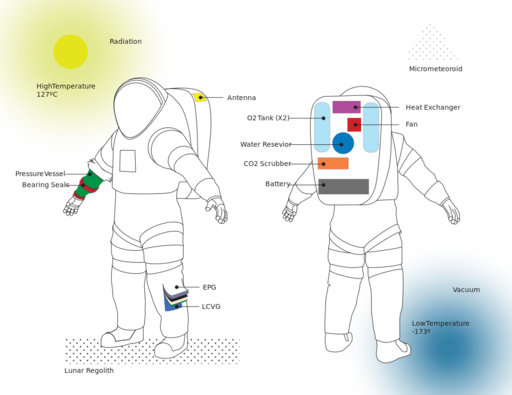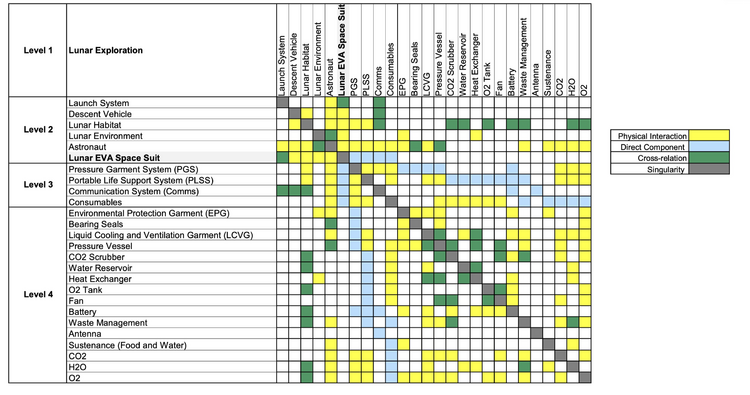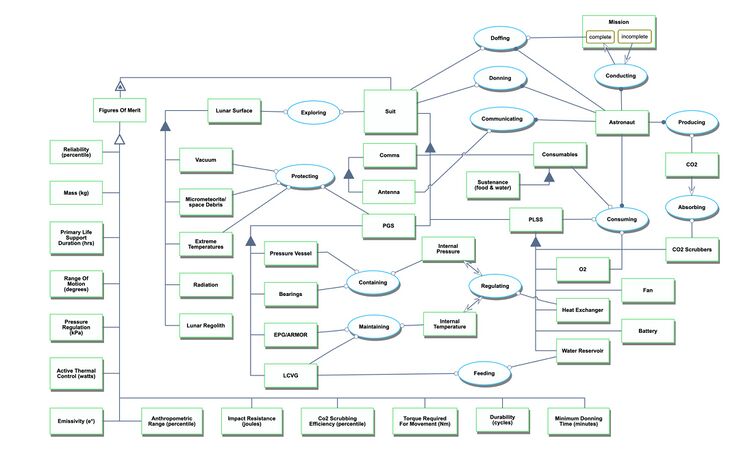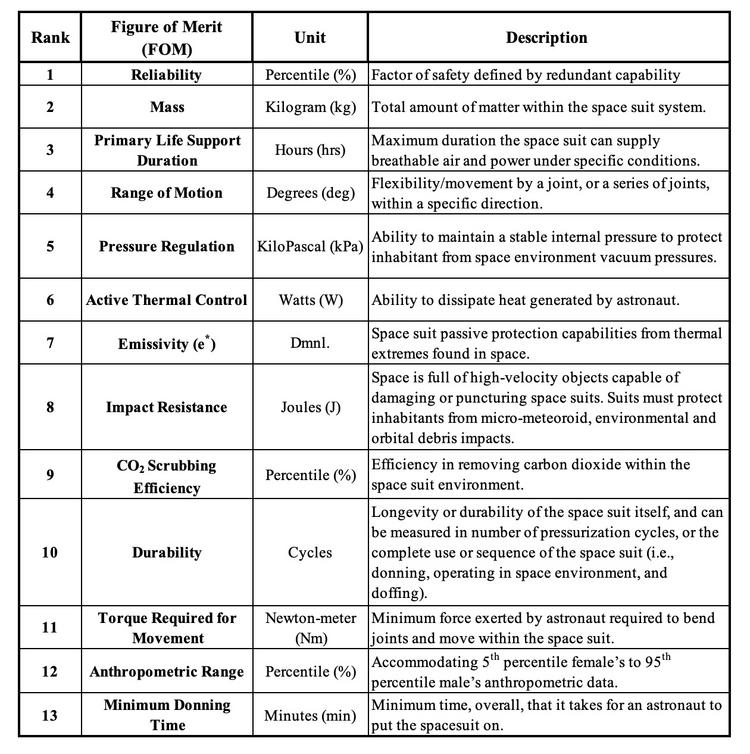Difference between revisions of "Lunar EVA Space Suit"
| Line 19: | Line 19: | ||
<br> | <br> | ||
[[File:Suit_Drawing_Wiki.svg]] | |||
==Design Structure Matrix (DSM) Allocation== | ==Design Structure Matrix (DSM) Allocation== | ||
Revision as of 21:46, 9 October 2024
Roadmap Creators
Technology Roadmap Sections and Deliverables
- 2SUIT Space Suits
We’ve chosen the acronym 2SUIT to represent our technology of a space suit. The 2 in our acronym implies the product level, with suits being a product within the level 1 system of lunar exploration. Our level 2 product level can be broken down into level 3 subsystems (portable life support, pressure garments, etc.) and level 4 components (bladder, O2 tanks, etc.). For the purpose of this roadmap we are considering the timeline from the late 1960s through 2030.
Roadmap Overview
Space suits enable survival and movement for humans outside of spacecraft in the harsh environment of space and fall into the category of “organism transportation.” They have been historically designed in response to specific environments – incorporating tools and aids for translation and tethering in micro-gravity and additional walking mobility features in partial-gravity, planetary environments.
With consideration for mobility, suits enable direct interaction with hardware during Extravehicular Activities (EVAs). During the Apollo program, suits allowed astronauts to safely explore the lunar surface to gather samples and learn firsthand about the environment of the Moon. The maintenance and upgrades on board the International Space Station similarly would not have been possible without the up-close, autonomy and physical interaction enabled by suits. With a new era of commercial spaceflight, the development of effective space suits will be fundamental for longer duration and more frequent missions – ensuring that humans can survive and function in these foreign environments.
Design Structure Matrix (DSM) Allocation
The matrix representing the technology of a Lunar EVA Space Suit visualizes the interdependencies with technologies on higher and lower levels for its own feasibility. The suit we are discussing is designed to support Lunar exploration, the level 1 system. This goal, or greater system, can be decomposed into level 2 product systems: a launch system, a descent vehicle, a habitat, the environment of the lunar surface, the crew or astronaut, and the space suit itself. These level 2 systems can each be individually decomposed into their subsystems. For the space suit, this means examining the level 3 subsystems: the Pressure Garment System (PGS), the Portable Life Support System (PLSS), the Communication System (Comms), and the consumables. These level 3 subsystems can be further decomposed into their individual components. The matrix allows the viewer to visualize the different relationships and connections within the space suit, whether physical interactions, subcomponents, or cross-system dependent/affected.
Roadmap Model using OPM
We provide an Object-Process-Model (OPM) of the Space Suit (2SUIT) roadmap in the figure below. This diagram captures the main object of the roadmap the space suit, its primary function to pursue lunar exploration in space, its decomposition into Level 3 subsystems (PLSS, PSG, Comms and Consumables), its characterization by Figures of Merit (FOMs) as well as the main processes (conducting the mission, exploring, communicating).
Figures of Merit
The above chart lists our interpretation of a comprehensive list of Figures of Merit pertaining to Space Suit Technology. Three important Figures of Merit (FOMs) are reliability, mass, and primary life support duration. Reliability is expressed specifically as a percentile representing the factor of safety defined by redundant capability. For example, the suit has a requirement for an oxygen tank, but for reliability, they have installed two oxygen tanks, that would contribute a 2x or 200% factor to the overall space suit’s reliability. Mass is the total amount of matter within the space suit system, measured in kilograms (kg). This is an important metric because it drives many other architectural and design decisions for the adjacent and supporting systems within the space suit. For example, all mass needs to be taken into account when calculating the required fuel/thrust for launch, which subsequently affects the overall mission cost. Primary life support duration refers to the maximum potential EVA duration, measured in hours, that the space suit can supply breathable air and power under specific conditions. This figure of merit is vital to mission planning success. A space suit that can support 8 hours of primary life support has the capability to accomplish missions that would be completely unfeasible or massively less convenient for a space suit that can only support 1 hour of primary life support.



